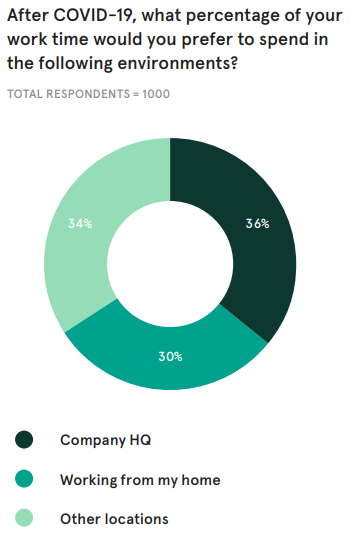The COVID-19 pandemic disrupted the global labor market throughout 2020, and some of this disruption continues to this day.
The unprecedented short-term consequences were sudden and shocking: Millions of people worldwide found themselves either furloughed or rapidly adjusting to a new normal of working from home for the foreseeable future.
While it comes with its challenges, there’s no denying that remote working, well, works.
Since the earliest days of the pandemic, many employees who formerly worked from traditional office environments have been vocal about their desire to retain an element of remote working in the future—and thus the idea of “hybrid working” was born.
What is ‘Hybrid Working’?
Hybrid working is expected to become a firm fixture in the post-pandemic working world. But what exactly is hybrid working, and how is it different from remote working?
Hybrid working has been described as the middle ground between working solely from one location, such as a corporate office, and working solely from home or from another non-work environment.
Unlike pre-pandemic homeworking where people were very occasionally able to spend the occasional day out of the office, hybrid working is a more blended approach. It allows employees to spend their time between their home and the office should they wish to, and it’s predicted to become a standard operating procedure for most organizations after the pandemic.
This is quite the contrast to the way things were pre-pandemic; it was only a small number of more progressive companies, typically younger start-ups, that truly enabled remote and flexible working for their employees.
Transitioning from Remote to Hybrid
Remote working during the pandemic was a resounding success. According to a survey by PricewaterhouseCoopers (PwC), 34 percent of employees believe that they are more productive now than they were before the pandemic, and 52 percent of executives agree.
Despite the success of remote working and the short-term advantages, it’s unlikely to stick around in its current form due to the long-term risks. Having a completely remote workforce can lead to problems like a lack of culture, less guidance for new recruits, and difficulty keeping workplace and client relationships healthy.
A hybrid working approach, however, offers the best of both. It’s a healthy middle ground between 100 percent remote working and 100 percent office working, allowing employees to split their time between the two. While there are no rules for this, many organizations are opting for an approach where employees are required to be in the office three days a week, with the remaining two days usable as remote days if employees wish—and 55 percent of workers do.

Research by WeWork suggests that employees now want to split their time evenly between the office, home, and other workspaces. Image credit: WeWork
5 Benefits of a Hybrid Work Model
Less than one-fifth of organizations want their employees to return to the office full-time after the pandemic. For the other four-fifths of organizations, adopting a hybrid approach will bring with it a whole suite of benefits in the post-pandemic climate.
1. It Improves Employee Work-Life Balance
The pandemic has made us all realize what’s important to us. While we all have different wants, needs, and desires, flexibility between our personal and working lives is something we all strive to achieve.
Thanks to the pandemic, however, workers now value flexibility more than ever. This is because we’ve all witnessed in our own way the increased flexibility that remote working has given us and the value this can translate to. A hybrid working approach allows employees to handle and respond to life more on their own terms. Childcare, supporting family members, and safeguarding our mental health are just a few things that hybrid working allows us to do better.
2. It’s Safer
COVID-19 is here to stay. While vaccines reduce the risk of developing severe symptoms and regular testing helps to identify asymptomatic cases and protect the most vulnerable, the risk of the disease will be sticking around for a while yet, if not indefinitely. It’s also important to remember that not everybody can be vaccinated due to medical problems.
A hybrid working model means that fewer employees are working on-site at the same time. On any given day, there’ll be a different mix of employees working from the office and working from home. This makes it much easier to manage social distancing, giving employees more peace of mind and protecting your most vulnerable staff.
3. It Enhances Engagement and Productivity
The opportunity to choose to work remotely helps employees disengage from daily stressors such as commuting and find more time for things that they value, such as engaging in hobbies and exercise. And while we all love our co-workers, being away from the hustle and bustle of the office also allows employees to mentally recharge.
A hybrid working model can therefore improve employee engagement and pump up productivity. Your workforce is far less likely to become burned out by being confined to the office for eight hours a day, five days a week.
4. It Future Proofs Your Organization
We all know that hybrid and flexible working are here to stay; they’re no longer the trends they were before the pandemic hit. And while we’re all hoping that the coronavirus will leave us forever, there are no guarantees that it will, and even if it does, what if another pandemic hits?
Organizations need to ensure that they are setting themselves up for long-term flexibility so that they’re able to respond to whatever might be thrown at them in the future. If another pandemic hits, the last thing that organizations and workers want is a repeat of the mayhem of early 2020.
5. It Makes Employees Happier
Autonomy is a big driver of employee satisfaction: If you allow your employees to make their own decisions about how, where, and when they work, you should expect overall satisfaction to improve. According to SurveyMonkey, employees who worked remotely reported feeling happier than their co-workers who had remained in the office.
There are plenty of reasons for this, from the benefit of employees being able to have full control over their schedules to simply working in their pajamas from home with their pets by their side. See also: Not having to commute, being able to exercise more, cook more, spend more time with family… there are plenty of factors to hybrid working that are making employees much happier.

